ملخص موجز للفرق بين القولبة المفرطة والقولبة 2k
في حين أن الحقن صب فوق القالب and 2K injection molding (also known as 2-shot injection moulding) share many similarities, they also have some key differences. See below for the difference between those two moulding processes.
القولبة بالحقن الزائد involves the use of a standard single-nozzle injection machine to combine two distinct types of materials into a single solid product. The overmolding manufacturing process means moving the first part (substrate part) or metal inserts to the subsequent mould (فوق العفن) to create the final product. You can use this technology to add a soft-touch grip to a tool handle or to create a product with multiple colors or textures.
حقن 2K, also referred to as multi-shot injection molding, 2-shot injection molding, or dual-injection molding, involves using a specialized 2K injection machine to simultaneously inject two or three materials (colors) into the same mold. In fact, the 2K injection machine actually has two installed moulds. Unlike overmolding, the 2K moulding machine simultaneously injects both materials, fully bonding them together once the moulding process is complete. The 2k molding process, while complex, is characterized by its speed, efficiency, and high quality.
Compared to both manufacturing technologies, 2K injection tooling offers superior quality and production efficiency. However, due to the high cost of the 2K injection moulding machine, صب فوق القالب sometimes serves as a substitute. On the other hand, the cost of an over-molded part is higher than that of a 2K injection-moulded part. However, for low volumes of 2-color moulding parts, injection overmolding can utilize any standard injection-moulding machine to produce the overmoulded parts.
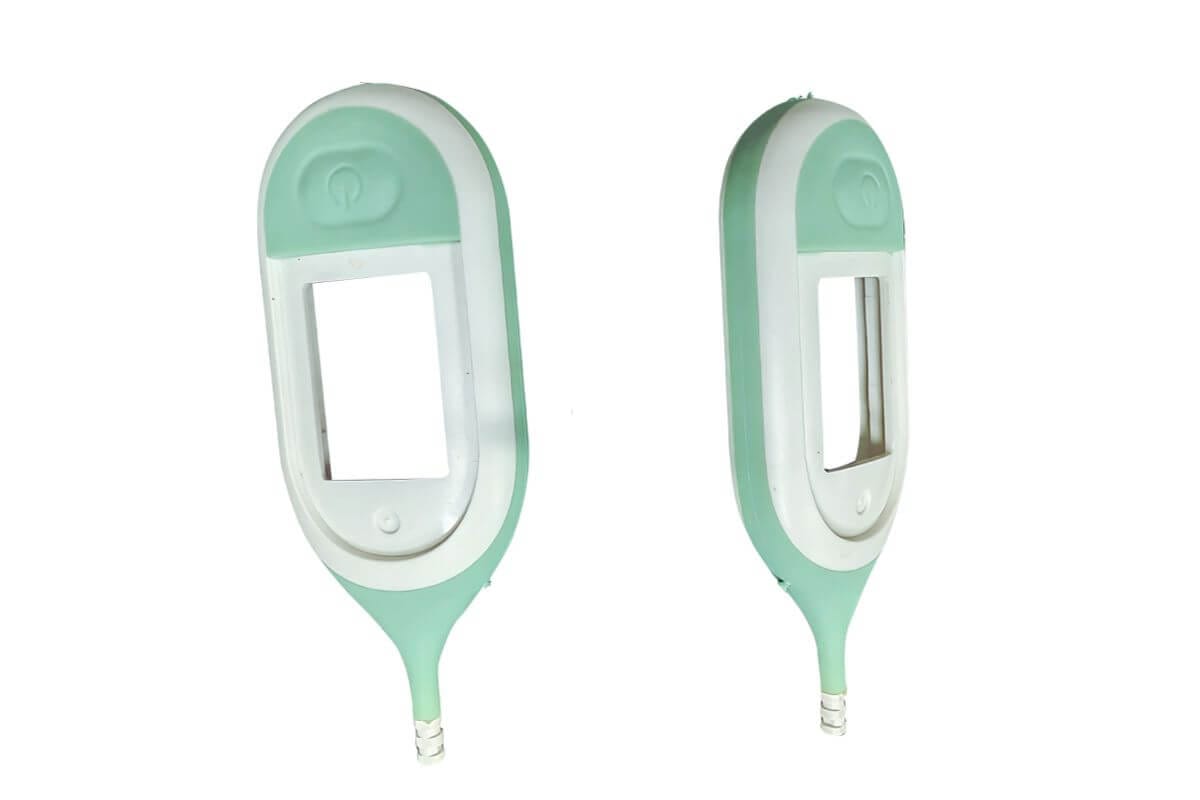
عند تصميم الأجزاء البلاستيكية متعددة المواد أو ثنائية اللون، من الضروري اختيار عملية التشكيل المناسبة بناءً على تصميم الجزء الخاص بك واحتياجات الإنتاج. كل من القوالب المتراكبة والقولبة بالحقن 2K have their own advantages and disadvantages. Some of the injection moulded prodcuts can only be created with the صب فوق القالب process, while some of the injection-molded parts can only be made with the 2K injection molding process; this is depending on the plastic part geometry design.
If both moulding processes can produce the plastic parts, the 2K molding process will be the most effective for high-volume production.
كلاهما صب فوق القالب and 2K injection moulding can be used to create products with multiple materials or layers, but the key difference is that in overmolding, two materials are formed separately (preloading the substrate to the second mould), while in 2K injection molding, two materials are formed together in the same process (of course, a specialized machine is needed).
ما هو التشكيل الزائد (القالب الزائد)؟
Overmolding, أو فوق العفن is a manufacturing process that involves molding one plastic over another material to be merged to create a single end product. In plastic overmolding, two separate moulds are required: the substrate, which is the first tool, and the overmould, which is the second mould. Typically, the second mould is made of thermoplastic elastomer (TPE) material, but this is not always the case. If the substrate is machined metal or brass components, then we normally call this insert molding, and insert moulding only needs one mould (over mould) to finish the manufacturing process.
المواد الأكثر استخدامًا للبلاستيك صب فوق القالب are thermoplastic elastomer (TPE), rubber, or the same material as the substrate but in different colors. Today, we will primarily focus on the تقنية القوالب المتراكبة التي تستخدم مواد البولي إثيلين ثلاثي البولي إيثيلين (TPE)، والتي تستخدم على نطاق واسع في مختلف الصناعات. يمكن تصنيع الركائز الصلبة من مجموعة كبيرة من المواد، بما في ذلك البولي إيثيلين (PE) والبولي بروبيلين (PP) والبولي كربونات (PC) والنايلون (PA6 أو PA66) وأكريلونيتريل بوتادين ستايرين (ABS), بولي ميثيل ميثاكريليت (PMMA)، والبوليسترين (PS)، والبوليسترين عالي التأثير (HIPS)، وأكسيد البوليفينيلين (PPO)، وأكريلونيتريل بوتادين ستايرين (ABS)، أو أي مواد أخرى ذات أغراض خاصة يمكن استخدامها كركائز.
صب فوق القالب تستخدم عملية القولبة بالحقن لحقن مادة بلاستيكية واحدة (Over-mold) over another material (substrate). The overmolding plastic material normally uses TPE, rubber, TPU, or the same material but in different colors. Overmoulded materials will make a strong bond with their substrates, ensuring long-term durability and optimal performance in their intended environments. The use of overmolding removes the need for adhesives when connecting thermoplastic elastomers (TPEs) to hard substrates. The overmolding تبسّط هذه التقنية عملية تصنيع القوالب وتقلل التكاليف وتتيح المزيد من المرونة في التصميم.
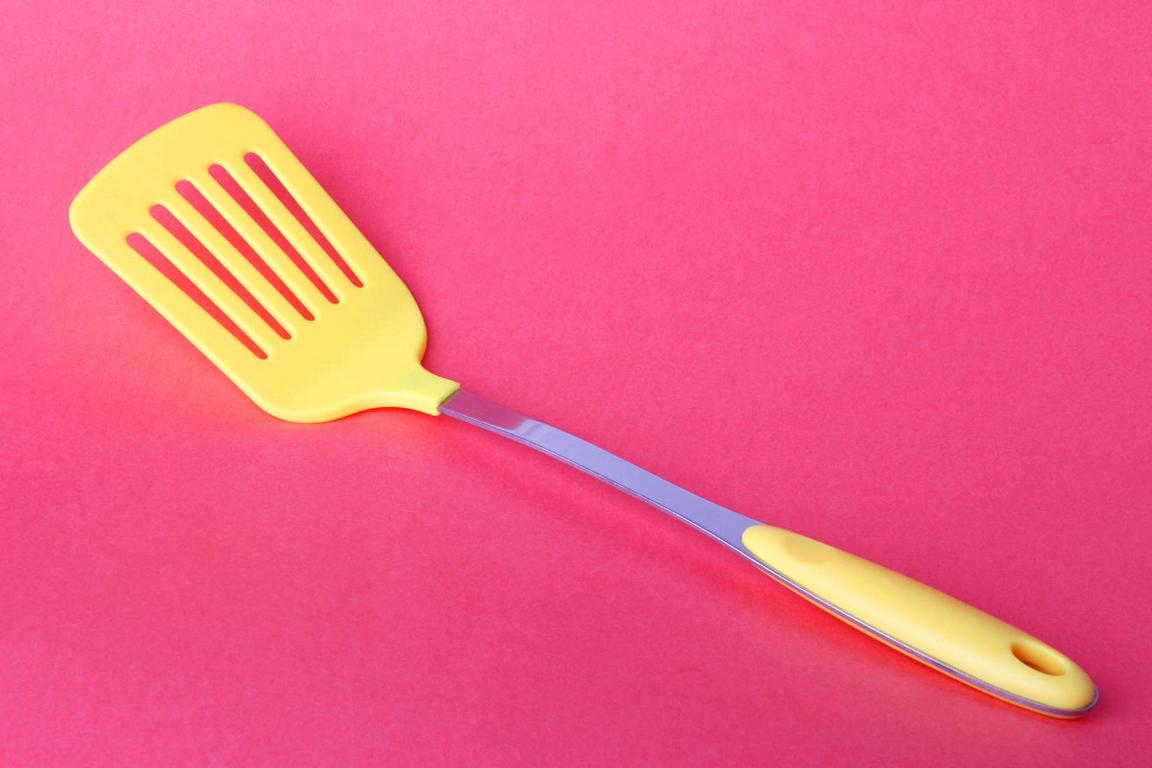
أنواع القوالب المتراكبة
Types of overmolding include two-shot sequential صب فوق القالب, insert moulding, and multi-shot injection molding (2K and 3K injection moulding, or more).
Two-shot sequential overmolding
في اللقطتين المتتابعتين حقن البلاستيك بالحقن الزائد, the molding machine injects the first plastic resin into the first mold cavity (substrate mould); after the material cools and forms the first plastic shape, it then opens the tool. All of those molding processes are the same as the traditional injection moulding process.
Once the first substrates are completely finished and cooled, insert the substrate into the second mold (overmold), close the tool, and then inject the second material. The process is also the same as the traditional molding process; the difference is preloading the substrate into the cavity before the manufacturing process begins.
All of those moulding processes will be done with traditional injection machines.
القوالب المتراكبة الخاملة
إدراج القوالب الزائدة يستخدم إدخالات مسبقة التشكيل أو إدخالات معدنية توضع في القالب قبل حقن المادة الثانية؛ إذا كانت الإدخالات معدنية أو نحاسية إدراج القالب. This overmolding process, which we used a lot, for example, metal screw insert moulding and قولبة إدراج الفلترفإن هذا النوع من صب زائد تستخدم ماكينة قولبة بالحقن التقليدية للمضي قدمًا، والتي تضع الحشوات المعدنية في تجويف القالب أثناء دورة القولبة بالحقن الواحدة.
Like the below picture is showing, the insert صب فوق القالب بمعدن خامل هذا النوع من القوالب الزائدة يتطلب قالب حقن واحد فقط؛ ومع ذلك، إذا كانت الحشوة الأولى مصنوعة من جزء بلاستيكي، فسنحتاج إلى قالب إضافي لجزء الحشوة البلاستيكية الأولى.
Multi-shot injection moulding or 2k injection molding
Multi-shot injection molding, sometimes called 2-shot injection moulding, is also a type of overmolding. This molding technology requires specialized injection moulding machines, which have two injection units. The injection barrels can be parallel or perpendicular to each other. There will be two injection moulds assembled in this machine; one injection tool makes the substrate, and the other one is for the overmolding process.
The moulding machine injects the first plastic resin into the first cavity, also known as the substrate mould. Once the material cools and forms the first plastic shape, it opens the tool. This process is identical to the traditional injection manufacturing process. Once the moulds are open, the movable half rotates 180° without ejecting the substrate. Next, it closes the molds and initiates the second injection, also known as the overmold.
Simultaneously, it injects the first shot. Once the second cavity completes its molding process, it opens the tools again and ejects the overmoulded product from the overmold. During this process, a new substrate is generated for the second cycle.
هذه دورة قولبة كاملة لعملية القولبة بالحقن 2k.
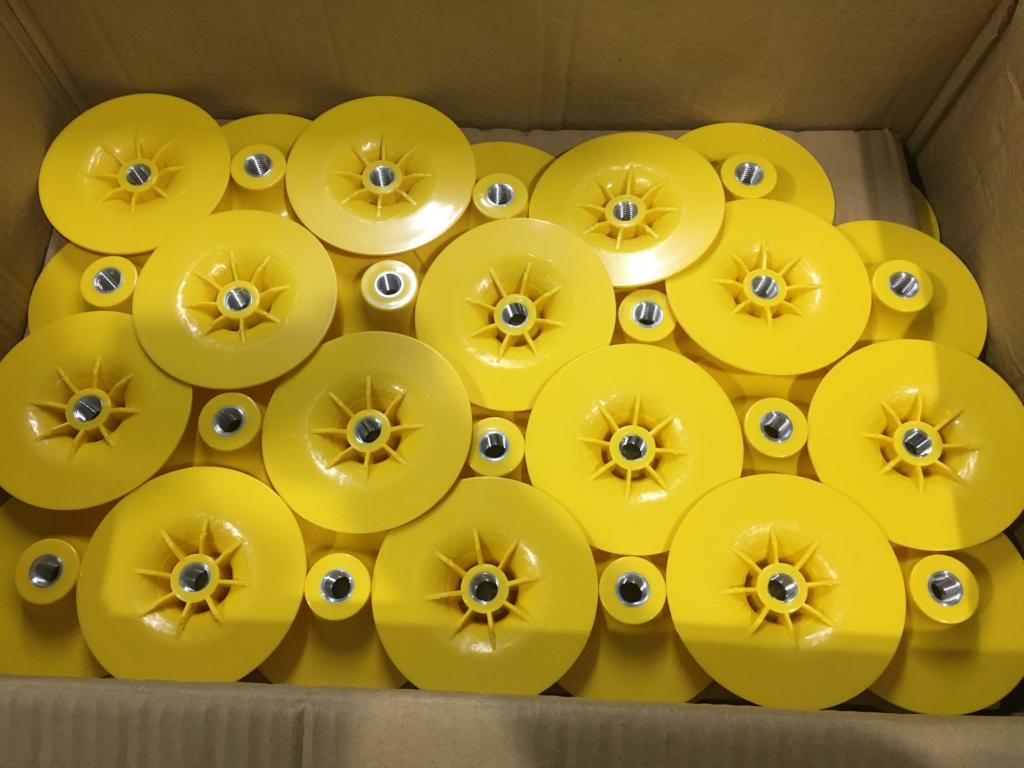
TPE overmoulding
TPE (اللدائن البلاستيكية الحرارية) plastic materials are used a lot in the injection molding field, especially for the overmolded parts. In the صب فوق القالب market, over 80% of overmolded parts are made by TPE فوق الصب فوق القوالب,
قالب فوقي من مادة TPE is the injection moulding process where TPE (thermoplastic elastomer) is formed onto a rigid material (for example, PC, PA66, or ABS material) according to the specific requirement. The overmolded TPE will strongly bond with the first plastic and maintain its final use purpose. To prevent the TPE material from stripping off from the second material, material selection and part design are very important.
A TPE الشركة المصنعة للقوالب المتراكبة ستأخذ في الاعتبار جميع العوامل ذات الصلة عند اختيار طريقة التصنيع المثلى للقالب لجزء مصبوب بحقن البلاستيك، والاختيار بين القولبة 2K وعملية التشكيل الزائد. تشمل العوامل الحاسمة القدرة الإنتاجية واختيار المواد والمعدات المتاحة وتكاليف العمالة.
عادةً ما يكون صب فوق القالب process is the most popular choice when total production volumes are less than 50K. This number is only a reference and not a definitive one because it depends on the size and complexity of the part design. For higher volume production requirements (total volume over 200,000 units), a 2-shot injection moulding process will be a better option; of course, this is still dependent on the part design because some parts can only be made with an overmoulding process; for example, the below part can only be created with the overmolding process.
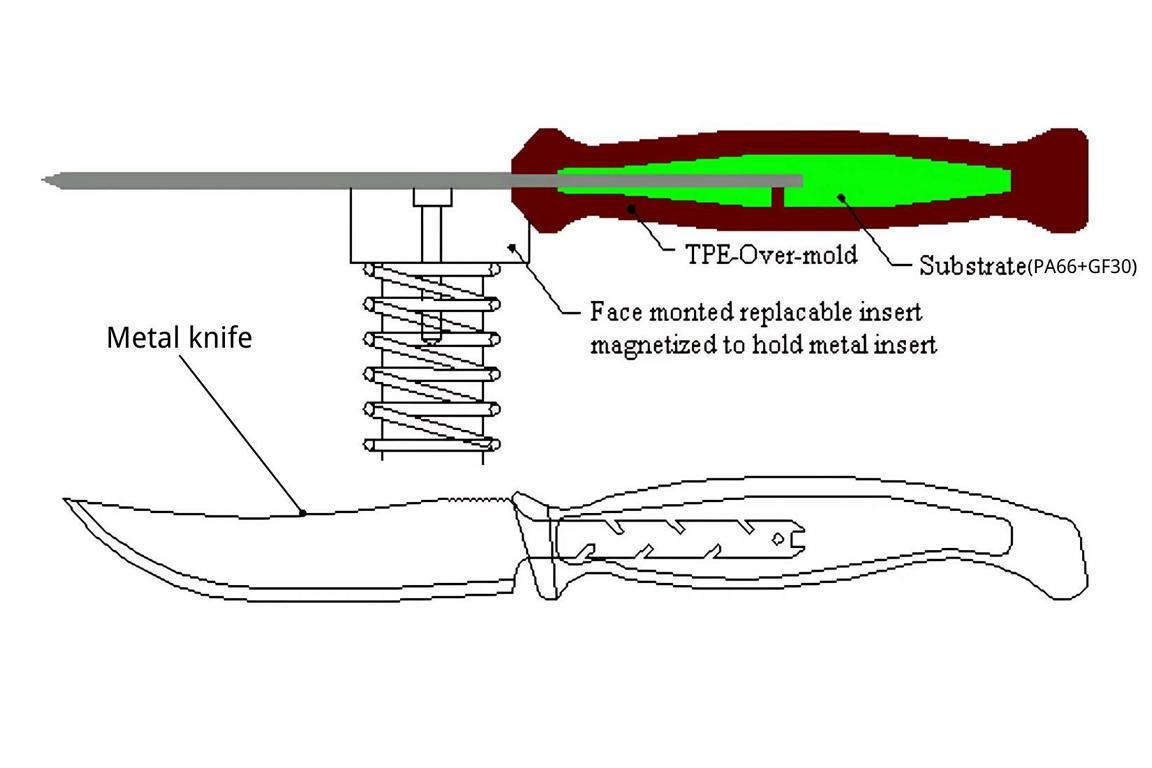
في كل TPE overmoulding or 2K injection molding process, the number one issue is to achieve maximum adhesion between the TPE and the substrate. Some TPE overmoulding may have significantly different bond strengths between multi-shot and overmolding. Even if an excellent bond is produced with two-shot molding, the same material may have a low bond strength when using صب فوق القالب. وبالتالي، لصنع تشطيبات نهائية عالية الجودة overmolding and 2K moulding products, a thorough understanding of TPEs, part design, engineering plastics, and the specifics of the moulding process is important.
نصائح اختيار مواد القوالب المفرطة من TPE
كما نعلم لصنع جودة عالية مصبوب فوقي من البولي إثيلين متعدد القوالب product, both TPE and substrate materials are most important, the number one factor to define the quality of overmoulded part is how good the mergeration between two matreials, if the TPE is easy to strip off from the substrate then the material will be issues, below there are some tips for meterials selestion, following thsi tips you will find the best suitable material for overmoulded part.
سُمك الجزء المصبوب فوق البولي إثيلين متعدد الألياف TPE
Designers frequently request the softest TPE. They don’t realize that a TPE’s soft durometer doesn’t provide much to “cushion” below a particular thickness (usually less than 0.1mm). Thinner TPE overmoulded part feel harder—the hardness impact depends on thickness. Multiple closely spaced ribs can produce the illusion of thickness without utilizing much material. Many kitchen utensil handle use this method.
صلابة المادة البلاستيكية TPE,
هناك نعومة لمادة TPE التي تحتاج إلى تحديدها عند إجراء صب TPE، خاصةً مادة TPE غير السميكة التي يزيد سمكها عن 0.5 مم. للحصول على إحساس جيد باللمس، قد تحتاج إلى اختبار أنواع مختلفة من مادة TPE الشاطئ A، ما لم تكن هناك متطلبات وظيفية خاصة، وعادة ما نستخدمها في السوق سوف تتراوح من TPE Shore A 40 إلى 60؛ إذا كان قليلًا جدًا، فقد يؤدي ذلك إلى تجريده من الركيزة؛ إذا كانت الصلابة عالية جدًا، فقد لا يكون الإحساس باللمس جيدًا بما فيه الكفاية.
نصائح لاختيار مواد الركيزة
بالمقارنة مع مادة TPE، سيكون من الأسهل اختيار مواد الركيزة؛ حيث يمكن أن تكون معظم المواد ركائز، بما في ذلك النايلون/PA (PA66 أو PA66 GF30 أو PA6 أو بلاستيك PA6 GF30)، والبولي كربونات (PC)، وأكريلونيتريل بوتادين ستايرين (ABS، PC/ABS، وأسيتال (POM)، وPMMA، وما إلى ذلك. يعتمد اختيار مادة الركيزة النهائية على الغرض النهائي. إذا لم تكن متأكدًا من المادة المثلى للأجزاء المقولبة من البولي إيثيلين تيرفثالات البولي إيثيلين (TPE)، يُرجى التواصل معنا وسنقدم لك بعض التوصيات.
تشطيب السطح على الركيزة والقالب المغطى ب TPE
سيؤثر تشطيب السطح على الركيزة أيضًا على التصاق مطاط TPE. كلما كان الالتصاق أقوى، قل احتمال تجريده، وعادةً ما يكون التلميع جيدًا بين سطح الدمج بين TPE والركيزة، على جانب تجويف TPE، لذا فإن تشطيب السطح في وقت ما سيؤثر على القالب الزائد TPE أيضًا، وفي بعض الأحيان سيؤثر تلميع higi على قالب تجويف TPE، فإن جزء القالب الزائد TPE سوف يلتصق بجانب التجويف، وإضافة بعض نسيج VDI الصغير سيحسن هذا.

نصائح تصميم الأجزاء المصبوبة فوق القوالب المصنوعة من البولي إثيلين متعدد الألياف
يلعب تصميم الأجزاء، كما ذكرنا سابقًا، دورًا حاسمًا في إنشاء جزء عالي الجودة صب TPE المنتج. بشكل عام، يتشابه تصميم جزء الركيزة مع تصميم أجزاء أدوات حقن البلاستيك الأخرى. لمزيد من التفاصيل، يُرجى الرجوع إلى الصفحة على تصميم جزء بلاستيكي للقولبة بالحقن. But there are some factors on the merge area between the substrate and TPE overmoled area; there is no standard design for this area since different parts have different geometries, but there are some key points that you need to think about when you do the overmoled part design. Those factors will be:
كيفية إحكام غلق القوالب المتراكبة من TPE بشكل جيد ومنع الوميض عند تصميم الجزء المتراكب:
TPE material easily exhibits flash (0.03 mm gap), and bondable TPE materials meet more stringent criteria than standard TPE polymers. The same holds true when designing parts. Unlike traditional part design, two-component part designs must account for shrinkage from two different thermoplastic materials. Both substrate and over-moulding have their own gate and runner systems, which must be tailored to the individual material properties used.
للوفاء بأفضل وقت للدورة والركيزة و صب فوق القالب يجب أن يكون سمك الجدار ثابتًا. في معظم تطبيقات التشكيل الزائد، يضمن سمك الجدار الذي يتراوح بين 1-3 مم الترابط المرضي. يجب أن تكون القطع الأكثر سمكًا محفورًا لتقليل الانكماش والوزن وزمن الدورة. لتجنب الردم وحبس الغاز، يجب أن تكون انتقالات سُمك الجدار تدريجية. أضف نصف قطر إلى المخاريط الحادة لتقليل مشاكل الإجهاد. تجنب الجيوب أو الأضلاع العميقة العمياء غير المتوفرة. يجب أن تكون السحوبات الطويلة بزاوية سحب من 3-5 درجات لسهولة إزالة القوالب. في المركبات المصبوبة فوق القالب، يمكن تصميم قواطع سفلية عميقة إذا تم استخدام قلب متقدم عند فتح القالب، ولا يحتوي الجزء على زوايا حادة، وينحني المطاط الصناعي أثناء الطرد.

Most TPE compounds have significant flow direction tool shrinkage and moderate cross-flow shrinkage. After ejection from the tool, the over-moulding compound may contract more than the substrate. This can stretch the substrate, usually in the overmolding material’s direction. This is especially true for long, thin parts or components with a low-modulus substrate or one thinner than the فوق العفن. استخدم مواد الركيزة ذات المعامل الأعلى وأضلاع التقوية للتخفيف من ذلك. تساعد الطلاءات الأقل سمكًا ودرجات القوالب ذات الصلابة المنخفضة على المساعدة. قد يساعد أيضًا نقل البوابة للتأثير على تدفق TPE.
إذا كان بإمكانك تحسين التصميم لضمان وجود رابطة أكثر إحكامًا بين مادة TPE والركيزة، مثل زيادة مساحة المقطع العرضي، دون المساس بوظائفها أو مظهرها، فسيكون ذلك مفيدًا. فيما يلي أحد الأمثلة على نصائح تصميم القوالب المتراكبة.
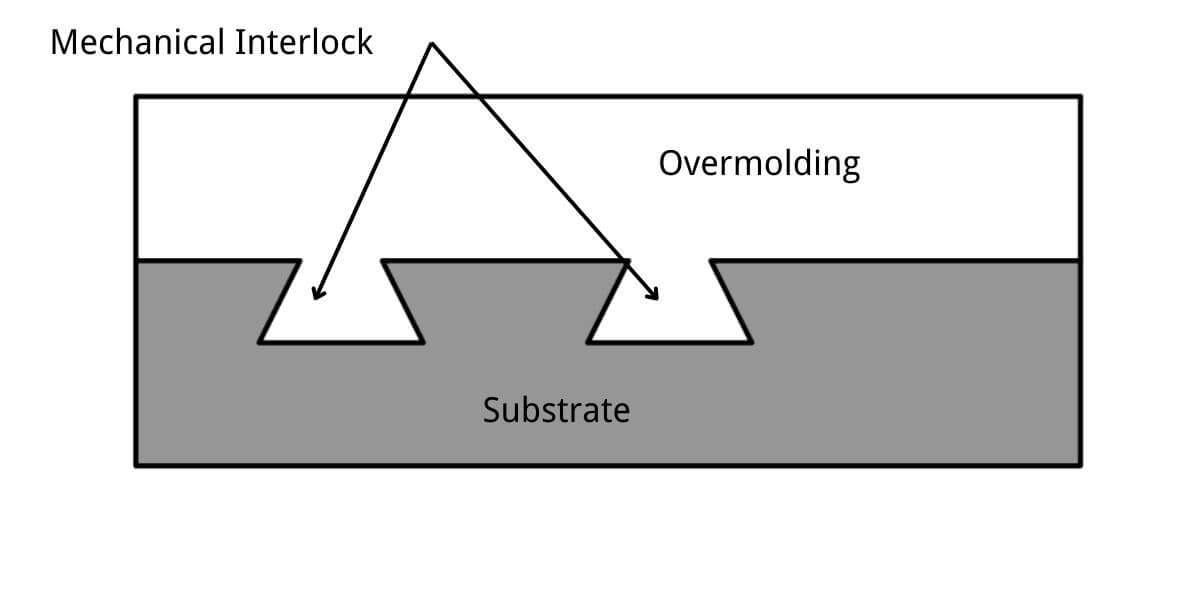
تجنب تصميم الكثير من المناطق المنفصلة على جزء القوالب المتراكبة من TPEحيث يمكن أن يؤدي ذلك إلى تعقيد تصنيع القوالب المفرطة وعملية التشكيل. تم تصميم العديد من المناطق بشكل خاص في منطقة خط الفراق؛ سيكون من الصعب حل مشكلة الوميض تمامًا عند تصميم الجزء المصبوب بشكل مفرط من TPE، وتصميمه بأبسط ما يمكن، ما لم يكن هناك غرض وظيفي ما.
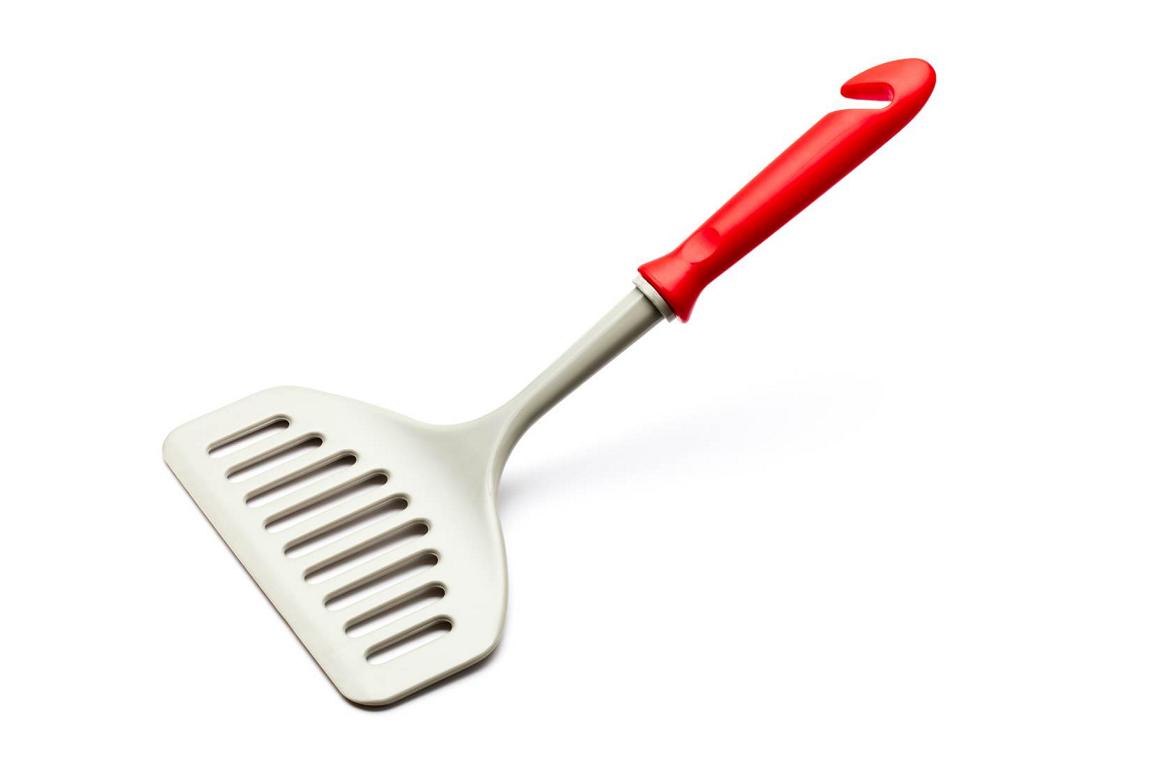
نصائح لتصميم القوالب المفرطة:
عندما نصمم قالب الحقن لـ صب فوق القالب الأجزاء، القالب الأول (أداة الركيزة) سنضيف معدل الانكماش وفقًا لمعدل انكماش البلاستيك، ولكن بالنسبة over mould (الأداة الثانية)، لن نضيف أي معدل شيناكج على الحقن فوق القالب.
تكلفة التشكيل الزائد
التكلفة الأساسية لـ صب فوق القالب ليس رقمًا ثابتًا يكون هو نفسه لكل تطبيق. فله قيمة متفاوتة يمكن أن تتراوح بين 1 و10 دولارات.
هذه شريحة سعرية واسعة للغاية. تتغير القيمة الصحيحة بناءً على عدة مكونات تدخل في عملية التشكيل الزائد. هذه العوامل التي تؤثر على التكلفة هي:
معدات القولبة بالحقن
يمكن أن تتغير التكلفة الأولية لمعدات القولبة بالحقن بشكل كبير اعتمادًا على تطبيقها ونوعها.
هناك معدات القولبة بالحقن صغيرة الحجم التي تحتفظ بها الشركات في المنزل. ثم هناك ماكينات القولبة الكبيرة التي يستخدمها عادةً مقدمو الخدمات والعاملون في الصناعة التحويلية كبيرة الحجم ذات أحجام الإنتاج الكبيرة.
صناعية مهنية صب فوق القالب تتراوح تكاليف المعدات بين $50,000 و$200,000. قد تكون هناك تكاليف شحن. هذه الماكينات ليست للهواة والهواة، لأنها تحتاج إلى مشغلين مهرة.
Overmold manufacturing costs
في حين أن صب فوق القالب المعدات هي استثمار لمرة واحدة، مما يخلق فوق العفن according to each custom design is an additional cost, and each single product design will require a unique over mould. It is an expense for every different part produced. over mold manufacturing costs are one of the most vital cost factors for overmoulded parts.
This over mold cost can vary depending on the part design, part size, and quality required to create the moulds. Generally, three factors are employed for this objective, which are listed below:?
تعقيد التصميم
Highly complex designs that requires complex overmold, this often include features like multiple cavities, intricate geometries, sliders, and lifters. These elements require advanced engineering, extended development time, and additional manufacturing cost, all of which increase overmolding tooling costs.
حجم الجزء
Over mold is the same as other injection moulds; a large size will require a large mouldbase and moulding machine, which will increase the over mold cost and unit moulded part cost.
تكاليف العمالة
Over mold is normaly hard than normal mold, because it needs perfect mold fitting, specailly is TPE overmolded on the substrate, TPE is very easy to go flash, the skilled technicians are needed to monitor machines, perform quality checks, and mold fitting operations, which adds to labor costs,
Since the the overmolding typically involves manual or robotic pre-loading the substrates into the cavity, the molding cost will be much higher than traditional molding cost.
Waste cost
Material waste from sprues, runners, and rejected parts adds to costs. Overmolding will have more reject costs than traditional costs; if one part is rejected, that means the substrate is wasted as well. Employing hot runner systems can minimize waste by eliminating runners, but these systems come with higher initial investment costs.
Final summarize for the overmoulding cost
إذا كنت تبحث عن مصبوب بشكل زائد parts for your custom injection moulding parts, then you do not need to pay any cost on the injection molding equipment, because your supplier should have this, but you need to pay for the over mold cost, over-moulding process cost, materials cost, packing cost, and so on. If you want to know the price of your صب فوق القالب المشروع، يرجى الاتصال بنا وسنقدم لك عرض أسعار خلال 24 ساعة.
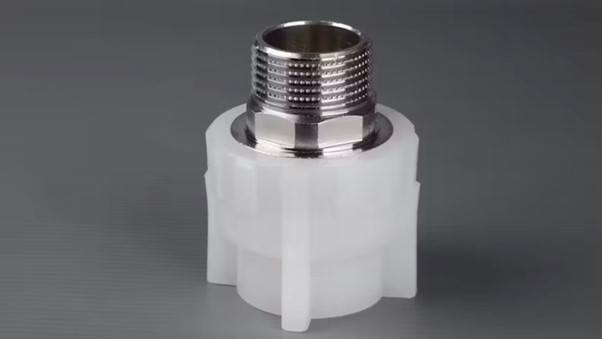
Metal insert moulding
كيفية تقليل تكلفة التشكيل الزائد
صب فوق القالب هي عملية التصنيع المفضلة نظرًا لفعاليتها من حيث التكلفة والموثوقية.
While the process is affordable compared to its alternatives, you can further decrease the costs. For that objective, here are some points that you need to take into account:
تحسين تصميم CAD
يمكن التعامل مع جزء واحد من خلال تصميمات CAD مختلفة. على أي حال، ليست كل فكرة تصميم مثالية. قد تؤدي بعض التصميمات لنفس الجزء إلى إهدار الوقت والموارد. لذا، يضمن تبسيط تعقيد الجزء من خلال تصميم CAD الفعال الاستخدام الأمثل للموارد.
تقليل حجم الجزء
الأجزاء الأكبر حجمًا ليست دائمًا أجزاء ممتازة. عندما يرتفع حجم الأجزاء، ترتفع تكلفة قوالب الحقن اللازمة للأجزاء. إذا كان من الممكن تحقيق نفس العملية عن طريق تقليل حجم الجزء، فمن الجيد اختيار ذلك.
إعادة التقييم على القوالب
Make full use of the over molds by reusing them for many applications. You cannot just use the same mold for the same part but also for similar parts as well, when you design similiar part you can even use interchangeable cavity and core to save the tooling cost.
Using DFM (Design for Manufacturing) Analysis
يرمز سوق دبي المالي إلى التصميم من أجل التصنيع. يشير سوق دبي المالي في القولبة المفرطة إلى إنتاج جزء يخدم هدف العميل ويكون في حدود ميزانيته المحددة.
A thorough DFM analysis helps align the design with manufacturing capabilities, for examle, ensure the design meets functional requirements without unnecessary complexity, and use lower-cost thermoplastic elastomers (TPEs) compatible with the substrate. which can lower down costs. Go to التصميم للتصنيع الصفحة لمعرفة المزيد.
Reduce Cycle Times as Much as Possible
There is a direct correlation between reducing cycle times and improving operational efficiency and costs:
Optimised Cooling Channels: better cooling linee design in the mold can reduce the amount of time needed for cooling and increase the quality of the part, this is same to traditional mold.
Decrease the amount of material waste
Efficiency in the use of materials is a primary factor in cost reduction, for high volume products requrirement, use hot runners in order to reduce the amount of scrap material resulted from sprues and runners.
Incorporating regrind material while ensuring that its percentage does not damage the quality of the item is an important step in the recycling process.
Make sure perfect mold fitting can reduce the waste as well, use stable injection molding machine can reduce the waste cost.

كلاهما صب زائد و 2k حقن صب are very similar processes, sometime both moulding processes can work on the same part, but something can only be created with single القولبة الزائدة أو القولبة بالحقن 2K، هذا يعتمد تمامًا على تصميم الجزء.
مزايا القولبة بالحقن الزائد
- مقارنةً بالقولبة بالحقن 2K, صب زائد is easier to make. You can use a normal injection machine to make two or three different colors in one molded part or two or three different materials in one end part.
- بالنسبة لبعض الكميات الصغيرة من مشاريع الأجزاء المصبوبة بلونين، لا تحتاج إلى قلب أو استئجار ماكينة صب بالحقن 2K؛ باستخدام مقولبة بشكل زائد العملية هي الطريقة الأفضل والأكثر فعالية من حيث التكلفة لتلبية متطلبات العملاء.
- فهو يزيد من تنوع التصميم ويعلي من شأن المنتج النهائي في العديد من تركيبات المواد.
- مع انخفاض تكاليف التجميع، يقل عدد الأنشطة أو العمليات الثانوية التي يتم تنفيذها على المنتجات النهائية. وهذا يقلل من تكلفة العمالة. كما أنه بعد التصنيع، لا يتم تكبد المزيد من التكاليف.
- وتتمتع الأجزاء بمستوى عالٍ من الثبات والتكوين حيث إنها بعد تركها لتتشابك ميكانيكياً تصبح واحدة.
- المنتجات مصبوب فوق القالب باستخدام البلاستيك تتمتع بمقاومة عالية للاهتزاز والصدمات بسبب راتنجات البلاستيك التي تم تركيبها بشكل مثالي.
- The plastic moulded parts are more reliable because there is no bonding at the production stage.
- تكون العناصر النهائية بالمعايير المطلوبة، مثل التصميمات اللافتة للنظر والمكونات الثابتة.
عيوب الحقن بالحقن على القولبة
- منذ فوق القوالب process involves moving the first substrate part to another over mold, the tolerance is not as good as in the 2K injection molding process.
- إن القدرة الإنتاجية ليست بنفس كفاءة القولبة بالحقن 2K، حيث إنها تتطلب روبوتات أو عمالة يدوية لإدخال الركيزة في الأداة المصبوبة بشكل زائد. سيستغرق ذلك بعض الوقت، وأحيانًا لا تكون معلمة الصب مستقرة، خاصةً عندما تكون هناك ركيزتان أو أكثر في أداة واحدة. سيؤدي ذلك إلى مشاكل إضافية ومعدل نفايات أعلى، مما يؤدي إلى مضاعفة كمية النفايات (من الركيزة والمواد المصبوبة بشكل زائد).
- مع عملية القوالب المتراكبة، هناك عدد أقل من الخيارات المتاحة من حيث توافق البلاستيك. قد لا تترابط بعض المواد معًا بشكل جيد أو قد لا تكون قادرة على تحمل درجات الحرارة والضغوط العالية لعملية القولبة بالحقن.
- There are no secondary practices carried out on the end products of over-moulding. When the plastic material becomes cold, activities and adjustments come to a complete halt.
- In cases where products are scarce, it is expensive to run such an operation. Sincerely, you need someone to put the substrate into over-mold, so the cycle time and production cost are increased accordingly.
- تتطلب عملية التشكيل الزائد عادةً قالبين، أحدهما للركيزة والآخر للقالب الزائد، وبالتالي فإن تكلفة الأدوات الأولية ستكون أعلى.
- صب فوق القالب هي عملية أكثر تعقيدًا من عملية القولبة بالحقن التقليدية، حيث تتطلب تنسيقًا دقيقًا بين نظامي الحقن وتصميمًا مناسبًا للقالب.
- إذا كانت هناك مشكلة في عملية القولبة الزائدة، فقد يكون استكشاف الأخطاء وإصلاحها وإصلاحها في عملية القولبة الزائدة أكثر صعوبة من عملية القولبة بالحقن التقليدية.
ما هو القولبة بالحقن 2k؟ (القولبة ثنائية الطلقات)
قولبة الحقن بالحقن ثنائي الطلقاتأو القولبة بالحقن 2K، هي عملية تصنيع تُستخدم لإنشاء لونين أو مادتين في بلاستيك واحد. تمزج تقنية القولبة ثنائية الطلقات هذه بين مادتين أو لونين مختلفين من المواد في جزء بلاستيكي واحد باستخدام ماكينة قولبة بالحقن 2K.
عملية الربط الكيميائي التي تنطوي عليها هذه العملية مهمة للغاية لأنها قادرة على دمج مادتين أو أكثر في جزء واحد. عند استخدام عملية تقنية القولبة بالحقن 2K، فإن اختيار المواد سيكون عاملاً مهمًا في نجاح المشروع من عدمه.
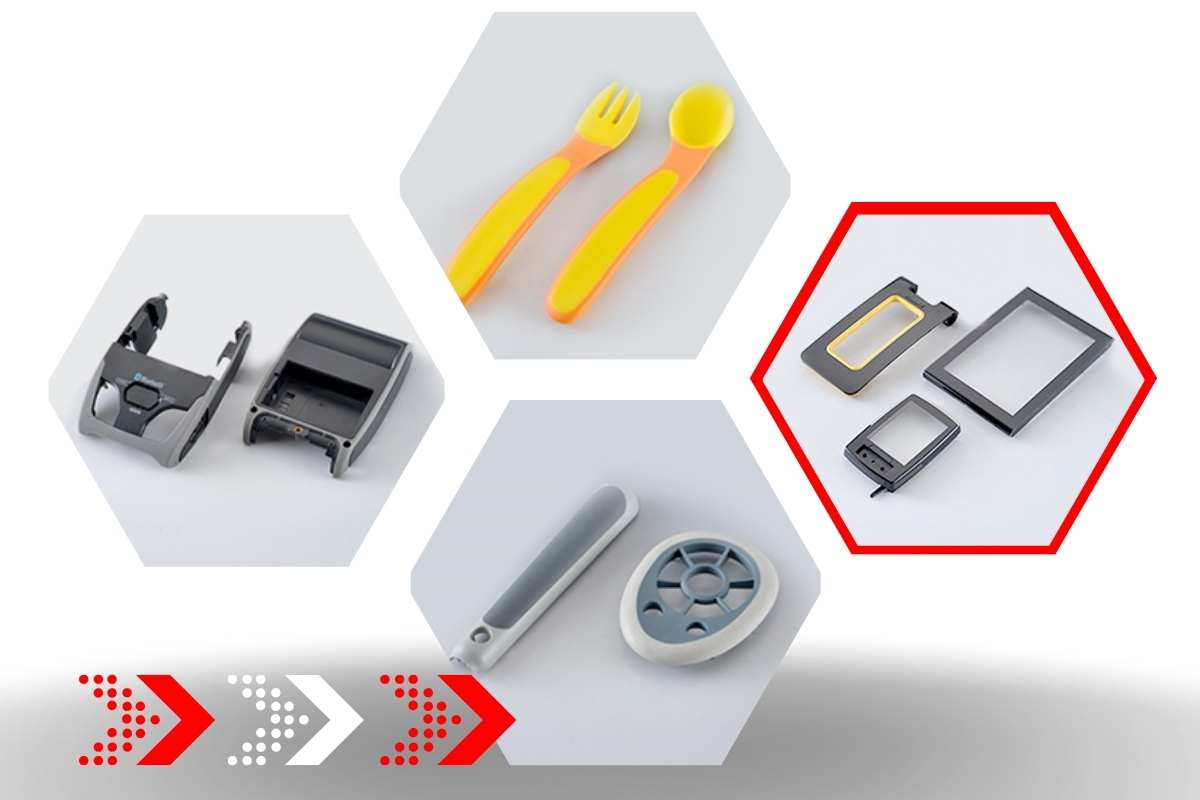
فوائد القولبة بالحقن 2K
قولبة بالحقن 2K عددًا من المزايا مقارنةً بالقالب بالحقن التقليدي أحادي المادة. وتتضمن بعض هذه المزايا ما يلي:
فعالة من حيث التكلفة
ال 2K injection molding process combines two compatible materials in a single machine cycle. It begins with the first material being injected into the primary mold. The moving half then rotates 360 degree, and close to eject the plastics for the second material to be overmolded in the secondary cavity. in the maintime the first injection is working synchronous.
The use of adhesives or further assembly is not necessary for this seamless technique, which guarantees the high quality bonding between the materials.
Because the method uses only one cycle instead of separate machine cycles, it costs less for any production run and needs fewer employees to make the end product while delivering more items per run. It also ensures a powerful bond between the materials without the need for additional assembly down the line.
تحسين الكفاءة
قولبة ثنائية الطلقات permits multiple components to be created with one tool, decreasing the amount of labor required to run your parts and eliminating the need to join or weld components after the molding process.
جودة أفضل
Two-shot is carried out within one tool, permitting lower tolerances than overmolding processes, a high level of accuracy and repeatability, and reduced scrap rates.
Solve the part design issues
قولبة ثنائية الطلقات يسمح بإنشاء تصاميم قوالب معقدة تتضمن مواد مختلفة للوظائف التي لا يمكن تحقيقها من خلال عمليات ما بعد التشكيل.
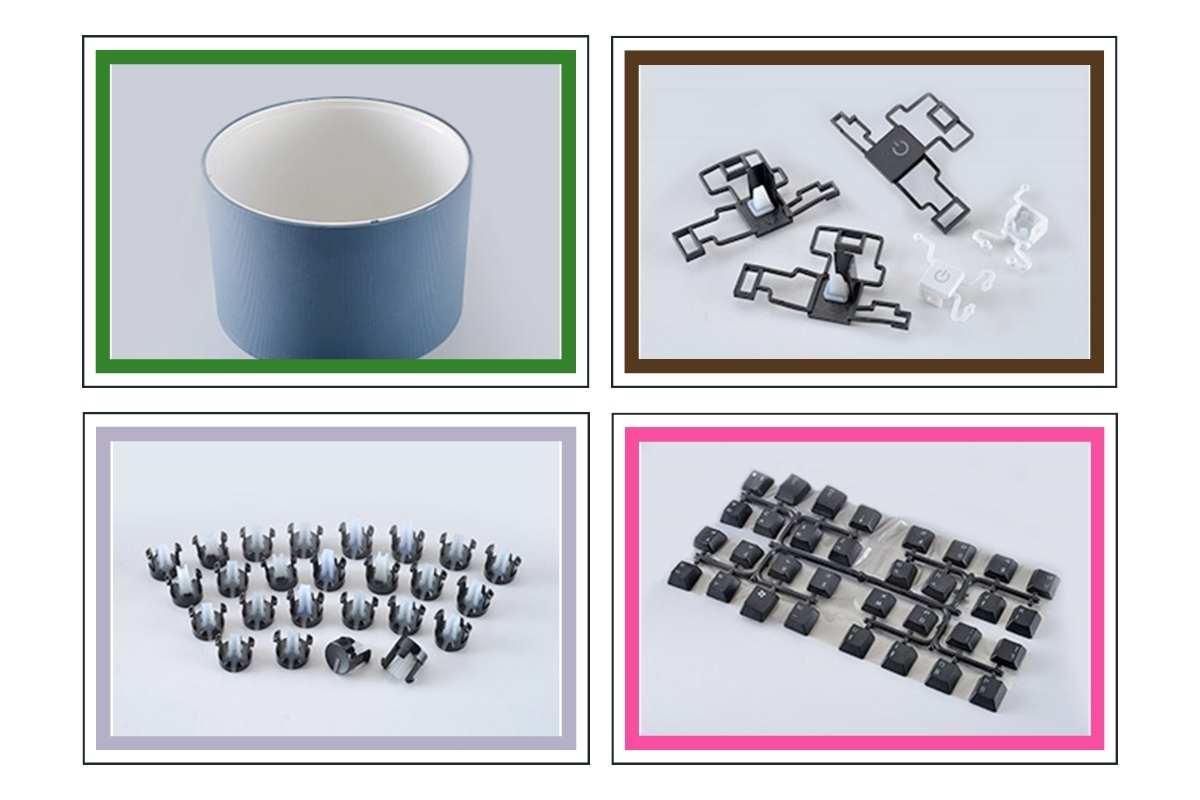
مساوئ القولبة بالحقن 2K
حقن 2K له العديد من المزايا، ولكن مثل كل شيء، له إيجابياته وسلبياته.
من عيوب حقن 2K هو أن تكاليف القوالب أعلى من قوالب الحقن التقليدية؛ لأن صناعة قوالب الحقن 2K تتطلب قالبين، القالب الأول والقالب الثاني (ولهذا السبب نسميها صب القالبين)، وصناعة قوالب الحقن 2K أصعب من صناعة قالبين منفصلين تقليديين لأن هذين القالبين سيعملان معًا في نفس الماكينة (ماكينة حقن القوالب ذات الحقنتين)، لذا فهي تحتاج إلى قالبين للتبديل دون أي مشكلة.
بالإضافة إلى ذلك، فإن حقن 2K يجب أن تستخدم العملية ماكينة حقن 2K، مما يجعل الماكينة أيضًا أكثر تكلفة ويتطلب مشغل فني خاص لضبط الماكينة. وهذه أيضًا تكلفة أعلى من أدوات الحقن التقليدية. في النهاية، نستعيد حقن 2K التكاليف من خلال تقليل تكاليف العمالة والتجميع، حيث لم يعد التطبيق اليدوي لختم، على سبيل المثال، ضروريًا. وهذا يلغي خطوة التجميع.
ومن العيوب الأخرى للقولبة بالحقن 2K أنها تجعل إعادة تدوير المواد البلاستيكية أمرًا صعبًا لأنه غالبًا ما يتم تجميع نوعين مختلفين من البلاستيك. حتى عندما تكون المواد البلاستيكية "من نفس العائلة"، فإن جودة التدفقات المرتجعة ستكون منخفضة للغاية، مما يجعل من الصعب إعادة استخدام البلاستيك في تطبيقات عالية المستوى.
كيفية اختيار خدمات القولبة الزائدة وخدمات القولبة بالحقن 2K
You may have questions about when you need to use over moulding and when you should use the 2K injection molding process. Here are some simple suggestions:
- If the quantity of the overmolding or 2K molding part is only a few thousand or ten thousand, it is recommended to use the overmolding process instead of 2k moulding process as it can significantly reduce mold costs.
- If you require more than 500,000 parts, 2K injection molding is the most cost-effective manufacturing process. This is due to the high labor costs associated with overmolding and the high initial cost associated with 2K moulds, two-shot injection moulding machines, and related equipment.
- القوالب المفرطة هي الطريقة الوحيدة المتاحة لبعض الأجزاء، في حين أن عملية القولبة بالحقن المزدوج مطلوبة للبعض الآخر. يعتمد ذلك على هيكل تصميم الجزء. إذا لم تكن متأكدًا، أرسل بياناتك إلى معلومات عنا. يمكننا التحقق من ذلك من أجلك وتقديم سعر للرجوع إليه.
Looking for over moulding or 2k injection molding service?
Sincere Tech هو واحد من أفضل شركات حقن البلاستيك في الصين. إذا كنت تبحث عن صب فوق القالب, insert moulding, صب 2Kأو أي قوالب مخصصة أخرى، أرسل لنا رسم التصميم ثلاثي الأبعاد الخاص بك ومتطلباتك؛ لن نشارك بياناتك مع أي شخص آخر. نحن على استعداد للتوقيع على اتفاقية عدم الإفصاح مستند لضمان سلامة مشروعك.
We will offer you the most competitive price for high-quality overmoulded parts, 2K tooling and moulding, plastic tooling, and plastic parts for the long-term business relationship, and we will suggest the best injection manufacturing process for your products.
More than 18 years of experience providing plastic mold making and custom mold services in overmolding, 2K moulding, die casting, machining, and so on, plus 18 years of fluent technical English communication (technical English communication is very important to work with worldwide customers).
تُقبل الطلبات الصغيرة. أسواق التصدير الرئيسية: آسيا، وأستراليا، وأمريكا الوسطى والجنوبية، وأوروبا الشرقية، وأمريكا الشمالية، وأوروبا الغربية، والعالم أجمع.





